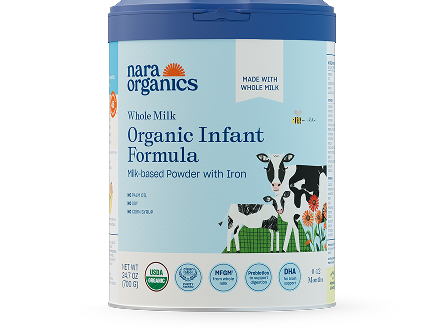Maria Murphy, RD
At Nara Organics, our formula intentionally uses a 1:1 water to powder ratio. This allows you to mix any size Nara bottle and minimize waste. Many U.S. formula brands use a 2:1 water to powder ratio, so if you’re new to Nara, or switching from another formula, please note that our preparation ratio might be different from how you previously prepared bottles.
More info and instructions are on the formula can and also provided below. If you have questions, we’re always here for you at hello@nara.com.
How to prepare a Nara bottle
To mix a Nara bottle, you’ll use 1 unpacked level scoop of powder for every 1 fluid ounce of water.
For example, to mix a 3 ounce bottle, pour 3 ounces of water into the bottle, then add 3 unpacked level scoops of Nara powder and shake to mix. For a 2 ounce bottle, add 2 ounces of water to the bottle, then add 2 unpacked level scoops of powder and shake to mix.
Always follow the 1:1 ratio! It’s simple and easy to remember. You can find the full mixing guide on your Nara cans. The guide is also below.


Safely preparing formula at home
Using proper hygiene at home when preparing bottles is very important. Common bacteria and pathogens live in our houses and kitchens; taking simple precautions can help prevent bottle contamination.
Washing & drying bottles and bottle parts
Here are some great recommendations from the Mayo Clinic to follow before you begin using new bottles — and in between feedings — to help keep your little one safe.1
- It's important to sanitize bottles thoroughly to remove as many germs as possible
- Clean the entire bottle, including the nipples, caps, and rings
- Don’t forget to disinfect the tools you’ll use for cleaning, like bottle brushes
The CDC also has helpful guidelines:2
- They suggest washing them in a clean basin/bowl (which is only used to clean infant feeding items) with dish soap and warm water
- Washing directly in the sink isn’t recommended because germs in the sink could contaminate bottle parts
- Rinse thoroughly under running water, then air dry items on a clean unused dishtowel or paper towel
- Do not use a dish towel to rub or pat items dry because doing so may transfer germs to the items
- There are also special drying racks just for pump and bottle parts, but clean towels do the trick
Sanitize
In addition to washing, your baby’s bottles and bottle parts should also be frequently (depending on the age or advice of your baby’s doctor) sanitized. The CDC recommends sanitizing daily (or more often) if your baby is less than 2 months old, was born premature, or has a weakened immune system.3
Methods to sanitize already cleaned bottles and bottle parts include the following:4,5
-
Use a dishwasher. Run on a sanitizing heat drying cycle. Allow to cool.
-
Boil. Place the disassembled feeding items into a pot and cover them completely with water. Heat the pot on the stovetop and wait until the water reaches a rolling boil, allowing the items to boil for five minutes.Lastly, use clean tongs, and carefully remove the items from the water and set them aside to dry on a clean paper towel.
- Steam. Place the disassembled bottles and feeding parts in the microwave or use a plug-in steam system. Follow the manufacturer’s instructions carefully for proper sanitizing, cooling, and drying.
We generally advise against using chemicals for sanitizing your baby’s bottles and bottles parts, or bottle brushes. Stick mainly to the cleaning methods listed above, as they are safer and effective options for sanitation.
Why does my 4 ounce bottle look bigger than 4 ounces?
When you add formula powder to the water, the powder takes up some space and makes it look like the level is higher than before (this is called displacement).
For example, for a 4 ounce bottle, fill the bottle with 4 ounces of water then add 4 unpacked level scoops of powder. Shake well to mix. You’ll end up with a bottle that contains slightly more than 4 ounces of formula.
This is normal! You’ve made a 4 ounce bottle — even though it looks slightly bigger.
You’ve got this!
You’re doing an amazing job keeping your baby fed and happy, however you choose to feed. If you have more questions about preparing formula, you can always talk to your pediatrician, or reach out to our medical team at Nara: hello@nara.com



